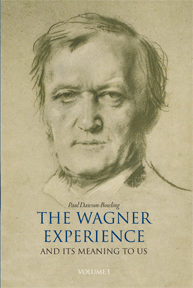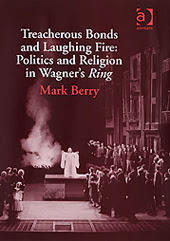The finalists for the 2014 The International Opera Awards have been announced with Wagner appearing extensively. At the same time Longborough Festival Opera - who last year staged their first entire Ring cycle were nominated as a finalist in Festival category. A full list of nominations can be found below.
Britten:
Peter Grimes on the beach (Aldeburgh Festival)
A Midsummer Night’s Dream (Parque Lage, Rio de Janeiro)
Gloriana (Hamburg Staatsoper/Royal Opera)
Verdi:
La forza del destino (Bayerische Staatsoper)
La traviata (La Scala)
Les Vêpres siciliennes (Royal Opera)
Verdi trilogy (Hamburg Staatsoper)
Wagner:
The Melbourne Ring (Opera Australia)
Parsifal (Metropolitan Opera)
Parsifal (Vlaamse Opera)
Das Rheingold (Grand Théâtre de Genève)
CD (Complete Opera)
Belisario (Donizetti), c. Mark Elder (Opera Rara)
Der fliegende Holländer/Le Vaisseau fantôme (
Wagner/Dietsch), c. Marc Minkowski (Naïve)
Königskinder (Humperdinck), c. Sebastian Weigle (Oehms Classics)
Otello (Verdi), c. Riccardo Muti (CSO Resound)
The Rape of Lucretia (Britten), c. Oliver Knussen (Erato/Warner Classics)
Serse (Handel), c. Christian Curnyn (Chandos)
Written on Skin (Benjamin), c. George Benjamin (Nimbus)
CD (Operatic Recital)
Andrzej Dobber: Arias (DUX)
Ann Hallenberg: Hidden
Handel (Naïve)
Bejun Mehta: Che puro ciel (Harmonia Mundi)
Xavier Sabata: Bad Guys (Aparte)
Chorus
Bayreuth Festival
Deutsche Oper Berlin
Metropolitan Opera
MusicAeterna—Perm State Opera
Welsh National Opera
Wexford Festival
Conductor
Teodor Currentzis
Mark Elder
Andris Nelsons
Gianandrea Noseda
Kirill Petrenko
Simone Young
Designer
Paul Brown
Aleksandar Denić
Robert Jones
Brigitte Reiffenstuel
Leslie Travers
Director
Calixto Bieito
Tatjana Gürbaca
Barrie Kosky
Martin Kušej
Dmitri Tcherniakov
Graham Vick
DVD
David et Jonathas (Charpentier), c. William Christie, p. Andreas Homoki (Bel Air Classiques)
The Gambler (
Prokofiev), c. Valery Gergiev, p. Temur Chkheidze (Mariinsky)
Médée (Cherubini), c. Christophe Rousset, p. Krzysztof Warlikowski (Bel Air Classiques)
Moby-Dick (Heggie), c. Patrick Summers, p. Leonard Foglia (Euroarts)
Pelléas et Mélisande (
Debussy), c. Stefan Soltesz, p. Nikolaus Lehnhoff (Arthaus)
The Rape of Lucretia (Britten), c. Paul Daniel, p. David McVicar (Opus Arte)
The Tempest (Adès), c. Thomas Adès, p. Robert Lepage (DG)
Female Singer
Diana Damrau
Christine Goerke
Anja Harteros
Christiane Karg
Petra Lang
Adrianne Pieczonka
Krassimira Stoyanova
Festival
Aix-en-Provence
Bregenz
Glyndebourne
Longborough
Pesaro
Wexford
Male Singer
Stéphane Degout
Bryan Hymel
Peter Mattei
Luca Pisaroni
Stuart Skelton
Michael Volle
Ludovic Tézier
New Production
Die Frau ohne Schatten, Bayerische Staatsoper
Guillaume Tell,
Rossini Opera Festival, Pesaro
Lulu, Welsh National Opera
Norma, Salzburg Festival
Die Soldaten, Oper Zurich
Les Vêpres siciliennes, Royal Opera
Wozzeck, ENO
Opera Company
Bayerische Staatsoper
Komische Oper, Berlin
Metropolitan Opera
Royal Opera, Covent Garden
Vlaamse Opera
Oper Zurich
Philanthropist/Sponsor
Edgar Foster Daniels
Alan and Jette Parker
Club des Mécènes
The Neubauer Family Foundation
Readers’ Award
Piotr Beczała
Joseph Calleja
Joyce DiDonato
Renée Fleming
Juan Diego Flórez
Anna Netrebko
Bryn Terfel
Rediscovered Work
Cristina, regina di Svezia (Foroni), Wexford
Elena (Cavalli), Aix-en-Provence
L’Olympiade (Myslivešek), Dijon-Caen-Luxembourg-Prague
Oresteia (Taneyev), Bard SummerScape
World Premiere
Champion (Terence Blanchard), Opera Theatre of Saint Louis
The Merchant of Venice (André Tchaikowsky), Bregenz Festival
Oscar (Theodore Morrison), Santa Fe Opera
Qudsja Zaher (Paweł Szymański), Polish National Opera
Spuren der Verirrten (
Philip Glass), Landestheater Linz
Young Singer
Emöke Baráth
Jamie Barton
Helena Dix
Joyce El-Khoury
Joélle Harvey
Duncan Rock
Corinne Winters
Pretty Yende





























.jpg)



























